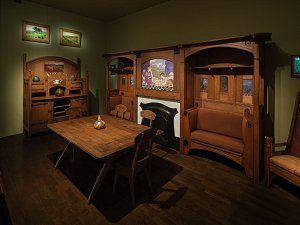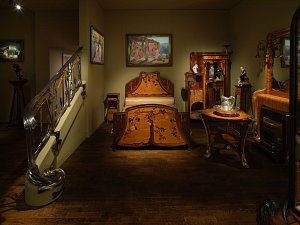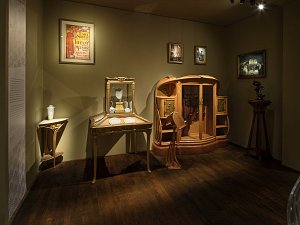At the end of the 19th century, a new art, Art Nouveau, seeking to go beyond the reinterpretation of past styles, became prominent in interior decoration. Considering the architecture of homes and furniture as a single art united by lines inspired by vegetation, decorators and cabinetmakers developed a global vision of the home in which functional objects, uniting beauty and practicality, provided a setting suited to modern lifestyles.
Art Nouveau spread all over Europe with variations. In France, the name of Siegfried Bing’s influential gallery, “L’Art Nouveau”, opened in Paris in 1895, became the name given to this movement.
Henri Rapin (1873-1939)

© MAD, Paris / photo : Christophe Dellière
Henri Rapin began his artistic training under Jean-Léon Gérôme and thus became an accomplished painter, illustrator and designer. The furniture shown here was commissioned from him by the surgeon Henri Marcille for his marriage to Cordélia Le Play in 1903 and are some of Rapin’s first pieces of furniture. Henri Rapin adopted an aesthetic influenced by the Constructeurs movement and by English Arts and Crafts, to which his friend Henri Bellery-Desfontaines, who had trained him, belonged. His furniture, rustic in style, in dark wood with rigid lines, is typical of the return to craftwork encouraged by the period. His intention was to be simple, he did not try to camouflage the structure of his furniture. He won the third prize in the Decorative Arts section at the 1904 Salon.
Louis Majorelle (1859-1926)

© MAD, Paris / photo : Christophe Dellière
Louis Majorelle is with Emile Gallé one of the founding members of the Ecole de Nancy, an association of artists and craftsmen created in 1901 to promote Art Nouveau in France. In 1879, Louis Majorelle and his brothers took over the family business based in Nancy, which until then had produced Louis XV style furniture and ceramics. From 1889, he renewed the production of furniture and in 1890 opened an ironwork workshop that produced stair railings and exterior ornaments such as forged balconies. A friend of the architect Henri Sauvage (1873-1932), he collaborated with him in 1898 on the decoration of the Café de Paris, located at 41 avenue de l’Opéra (destroyed in 1955), from which this fireplace comes. In 1900, he designed the bedroom furniture for Georges Rouard, director of the Parisian gallery “A la Paix”, which specialized in modern decorative arts. Majorelle triumphed at the Universal Exhibition in Paris in 1900. He turned to the mass production of furniture with simple shapes, usually in mahogany, decorated with bronzes featuring stylized plant motifs such as this model of water lily pedestal table.
Georges De Feure (1868-1943) and Alexandre Charpentier (1856-1909)
Georges de Feure’s work is presented to the right of Eugène Grasset’s stained glass “Le Printemps”. Born in Paris to a Dutch father and a Belgian mother, Georges de Feure, or to use his real name Georges Joseph van Sluitjers, settled in Montmartre in 1889 and had a brilliant career as a symbolist painter. The dealer and collector Siegfried Bing, who specialized first in Japanese art, opened the gallery called “L’Art Nouveau” in 1895 at 22 rue de Provence in Paris, where he recreated interiors designed by various artists such as Eugène Gaillard and Edward Colonna. In 1901, he made this side table in gilt wood for the “L’Art Nouveau”, decorated with a poppy. He exhibited this gilt wood display case at the salon of the Société Nationale des Beaux-Arts. It was filled with porcelain designed by de Feure and made at Limoges by the GDA (Gérard, Dufraisseix, Abott) factory, and sold by Bing.

© MAD, Paris / photo : Christophe Dellière
The second part of this section presents the furniture of Alexandre Charpentier, at once medal engraver, sculptor, cabinet maker, tin potter and ceramicist. In 1901, while he was working on wood panelling for the dining room of the rich banker Adrien Besnard, now at the Musée d’Orsay, he exhibited this cabinet for a quartet at the Salon de la Société Nationale des Beaux-Arts, made from hornbeam with its blonde hues, designed to hold two violins, a viola and a cello. It was accompanied by two double-sided music stands with organic lines. A violinist and close friend of Debussy, Charpentier was familiar with the requirements of these music cabinets. The cupboard and the music stands were bought from the artist by the Musée des Arts Décoratifs in 1906.